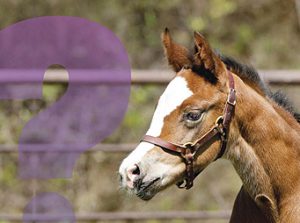Pricing Foals – One Part Art, One Part Science, but Mostly a Gamble
Click here to read the complete article146 – January/February 2019
By MEGAN ULRICH
 After waiting 11 months, the day has finally arrived. A beautiful, bright-eyed, wobbly-legged baby has joined your herd. Even though he’s only one day old, he has already accrued quite the list of expenses – from the stud fee to the cost of feed and vet care for the expectant mare, and more. The goal, if the baby will be offered for sale, would be to recoup those expenses and, of course, turn a profit. But recent discussion in the industry has many wondering how to fairly price their babies.
After waiting 11 months, the day has finally arrived. A beautiful, bright-eyed, wobbly-legged baby has joined your herd. Even though he’s only one day old, he has already accrued quite the list of expenses – from the stud fee to the cost of feed and vet care for the expectant mare, and more. The goal, if the baby will be offered for sale, would be to recoup those expenses and, of course, turn a profit. But recent discussion in the industry has many wondering how to fairly price their babies.
Weanlings and yearlings, that have not yet been campaigned, shown, or won any money to help ascertain their value, can be a gamble for buyer and seller alike. As an example, trainer and prominent breeder, Nancy Sue Ryan, recalls selling a baby for $7,500. That same horse went on to later be sold for $22,500.
When only time will tell if a horse will become a multiple World Champion, or if it won’t even make it to the show pen, how does one assess a fair, but profitable, price? Professionals from across the industry have come together to offer their best insights into factors that impact a young prospect’s price tag, from bloodlines and eye appeal to futurity eligibility.
FIRST, CONSIDER YOUR PERSONAL GOALS AND SITUATION
Before selling any horse–foal or otherwise–surveying your goals and financial situation is necessary. Consider, for example, whether you’re financially able to keep the baby for long enough to show and promote it in order to set it up for success. Decide whether your facility is adequate and if you yourself can train the prospect, or if you will front money for a trainer. Keep in mind any foals you have planned for the following year, as well. If, after considering those factors, the prospect winds up for sale, renowned Halter trainer Mike McMillian explains three methods of pricing a foal. “If you’re not anxious to sell, price it high. If you’re mildly pleased with it and are willing to take some risk, price it moderately. If you don’t think it will fit your program, price it low. Selling babies is risky because they change frequently at certain stages. At best, it’s an educated guess as to their success later on in life,” McMillian says.
But, that educated guess will be more accurate after considering the following factors that contribute to price.
Click here to read the complete article146 – January/February 2019










